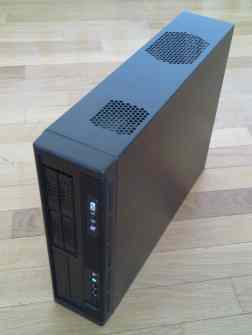The new 2011 ArchivistaBox models are here
Pfaffhausen, 8 February 2011: we are pleased to be able to present the new ArchivistaBox models. As of now, we offer updated box models for both the DMS systems and virtualization. The new features are outlined below.
 Minimum size and power consumption: Säntis, Dolder and Rigi ArchivistaBox systems
Minimum size and power consumption: Säntis, Dolder and Rigi ArchivistaBox systems
Let's start with the ArchivistaBoxes, our tried-and-tested DMS systems. You now receive significantly smaller ArchivistaBox systems with the Dolder, Rigi and Säntis models. The new Mini models occupy less than half the space they previously did. The Dolder and Rigi models now also have a fast AMD CPU built in, while the Säntis model features an extremely power-saving quad-core CPU. For all new Mini box models, power consumption under load is max. 50 to 60 Watts.
Naturally, the new Minis are perfect for the 64-bit version of the ArchivistaBox. This means that, from now on, all Dolder, Rigi and Säntis boxes are shipped with 64 bit. The Mini box is also used for the Mythen and Rothorn scan boxes.
The prices for the basic models remain the same. The ArchivistaVM option has been dropped because each ArchivistaBox solution now also includes the ArchivistaVM module. This now gives you the choice of whether to operate the ArchivistaBox natively or virtually. And, as always, you can also run one to two additional virtual instances (Windows, Linux etc., at 32 or 64 bit) on the ArchivistaBox Säntis. We don’t think that you’ll get this much flexibility and operational security from any other DMS solution.
ArchivistaBox Pilatus: redundant hard drives and virtualization
With the more advanced Titlis, Eiger and Matterhorn versions, you get two ArchivistaBox systems. This is not the case with the ArchivistaBox Pilatus, where only one box is shipped. New with the ArchivistaBox Pilatus: you receive two hard drives in a RAID1 array, i.e. the data is saved twice.
Here, as with the ArchivistaBox Säntis, you can now operate two additional virtual instances. Whether you are running test instances, performing a backup check or wishing to run operating systems independently of the ArchivistaBox, it’s is entirely up to you.
ArchivistaVM Budget: more performance and redundancy for the same price
It was almost two years ago that we assembled the first ArchivistaVM server for a customer project. Back then we based our calculations on approx. SFR 4,000.00 to SFR 5,000.00 per server; hot swap and RAID arrays were ‘must-haves’ in our eyes. Six months later, the ArchivistaVM Budget solution was created (also as a result of a project). This makes virtualization possible from SFR 990.00 (approx. €700.00). However, we couldn’t manage hot swap and RAID at that price. Now you get 8 GB RAM and two redundant, hot swappable hard drives at 500 GB each as part of the basic package for this price.
ArchivistaBox Summit: the same performance for half the price
The ArchivistaVM Summit solution was created to enable the operation of hot swappable 3.5-inch hard drives in a RAID array in the smallest of spaces. Eighteen months ago, this achievement had its price: the ArchivistaVM Summit cost a respectable SFR 3,990.00 back then. Now you can get the ArchivistaVM Summit solution for less than half of its previous price, true to our slogan: You can get exceptional performance for an exceptional price.
With the ArchivistaVM Summit+ (Plus) solution, you get four drives instead of two, i.e. instead of 2 TB (RAID 1), you get 4 TB (Raid 10).
 ArchivistaVM Universal: hot-swap hard drives and considerably more speed
ArchivistaVM Universal: hot-swap hard drives and considerably more speed
We originally planned to use solid state hard drives (SSD) for the first time on the ArchivistaVM Universal. We also ordered the appropriate drives. To be honest, we were seriously impressed with the speed of the drives tested (up to 1 GB throughput per second). However, this speed was only achievable because the corresponding PCI hard drives contain so-called fake RAID controllers. Fake RAIDs are hard drive arrays which are set up in BIOS, but cannot be operated without software drivers.
While these drivers can be embedded relatively easily in Linux, their range of functions is rather limited, depending on the manufacturer. We could operate RAID 1 (mirrored) or RAID0 (array without mirroring). However, RAID10 (mirroring and array) didn't work with either of the two controllers tested (AMD, SIL).
For that reason we decided to equip the ArchivistaBox 64Bit (and/or ArchivistaVM as a module) with the option for RAID arrays (software RAIDs). Due to the fact that we and our customers place great importance on hot swappable solutions for hard drives. That’s why we weren't terribly enthusiastic about the RAID arrays with PCI hard drives. No offense to DIMM swaps, but defective SSD memory modules cannot be exchanged without unscrewing the unit while it is turned off.
The new ArchivistaBox model Universal satisfies all requirements in this respect. The standard version is shipped with four hard drives, while the Universal+ (Plus) model comes with 6 hard drives. The ArchivistaVM Universal solution can also be fitted with standard 2.5-inch hard drives. Due to the hard drive arrays (RAID 10), the speed can be tripled, while simultaneously mirroring the data to two hard drives.
These new models are available now from our online store. All solutions include a maintenance contract for the first year. This covers free replacement within 8 business hours (in case of hardware defects), as well as emergency support within the same timeframe. Naturally, you can also receive completely installed virtualization environments (incl. clustering) at a fixed price from us and our sales partners. Furthermore, we are continually refining our solutions. As a customer you also benefit from these improvements without having to dig into your pockets once again.

